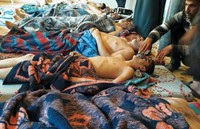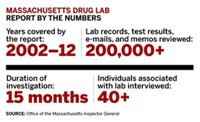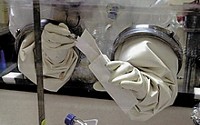Advertisement
Grab your lab coat. Let's get started
Welcome!
Welcome!
Create an account below to get 6 C&EN articles per month, receive newsletters and more - all free.
It seems this is your first time logging in online. Please enter the following information to continue.
As an ACS member you automatically get access to this site. All we need is few more details to create your reading experience.
Not you? Sign in with a different account.
Not you? Sign in with a different account.
ERROR 1
ERROR 1
ERROR 2
ERROR 2
ERROR 2
ERROR 2
ERROR 2
Password and Confirm password must match.
If you have an ACS member number, please enter it here so we can link this account to your membership. (optional)
ERROR 2
ACS values your privacy. By submitting your information, you are gaining access to C&EN and subscribing to our weekly newsletter. We use the information you provide to make your reading experience better, and we will never sell your data to third party members.
Policy
Anthrax Probe Under Scrutiny
National Research Council review of the science used in the FBI's Amerithrax investigation is under way
by William G. Schulz
August 17, 2009
| A version of this story appeared in
Volume 87, Issue 33

The Federal Bureau of Investigation’s probe into the 2001 anthrax mailings that left five people dead—known as the Amerithrax investigation—is now under the microscope of a National Research Council (NRC) review panel. Specifically, the FBI, which requested the study, has asked the panel to look at the scientific approaches, methodologies, and analytical techniques the bureau used to finger its latest suspect in the case, the late Bruce E. Ivins, a government biodefense researcher.
At a two-day meeting in Washington, D.C., at the end of July, the panel heard from the FBI as well as from scientific experts and a congressman who has been critical of the bureau’s handling of the case. At this first meeting, the NRC panel discussed its charge and heard about the techniques employed by the FBI in its nearly eight-year investigation.
“We will only review the scientific information” used in this case, said NRC Panel Chair and Lehigh University President Alice P. Gast as she formally opened the first session. “We will not address any aspects of the case not related to the science,” she continued. “We will not express any views on the guilt or innocence of any person or persons” related to the crimes.
The Amerithrax investigation received renewed scrutiny last year after Ivins killed himself just as the bureau intensified its investigation of him as a lead suspect in the case (C&EN, Aug. 11, 2008, page 13). The evidence against him was the tracing of spores in the anthrax mailing envelopes back to a flask under Ivins’ control at the Army Medical Research Institute of Infectious Diseases, at Fort Detrick, in Frederick, Md. Aside from this, no physical evidence has been released that ties Ivins to the crimes.
FBI Laboratory Director David C. (Chris) Hassell told the panel that although the bureau is “confident” in its conclusions, it wants NRC to review all the techniques of biological and chemical analysis it employed. “Did we apply these techniques in a reliable way?” he asked as he formally addressed the panel at the meeting.
The FBI requested the NRC study because it wants to validate and assess the reliability of the microbial forensics techniques used in the investigation, many of them new to science at the time, new to forensics, or both. The bureau and others say validation of these techniques will be important in the event of future bioterror attacks. They note that because Ivins killed himself before formal charges could be brought against him, the techniques used in the FBI’s investigation will likely never be subjected to rigorous review and cross-examination in court.
Microbial forensics has been defined as a field combining the principles of public health epidemiology and law enforcement to identify patterns in a disease outbreak, determining which pathogen could be involved, and tracing the organism to its source. Microbial forensics has also been used, for example, to investigate the intentional infection of victims with HIV.
According to NRC documents, the areas of scientific evidence from the anthrax investigation to be studied by the 15-member panel include, but are not limited to, genetic studies that led to the identification of potential sources of Bacillus anthracis recovered from the letters; analyses of four genetic mutations that were found in evidence and that are unique to a subset of particular anthrax strain cultures collected during the investigation; chemical and dating studies that examined how, where, and when the spores could have been grown and what, if any, additional treatments they were subjected to; studies of the recovery of spores and bacterial DNA from samples collected and tested during the investigation; and the role that cross-contamination might have played in the evidence picture.
The panel will be working with the FBI over the coming months to review as much of the science in the investigation as possible, Gast said. She noted that the National Academies, the parent organization of NRC, has the ability to deal with classified information should that become necessary. The panel hopes to have a final peer-reviewed report in about 15 to 18 months, she said.
The report can’t come soon enough for Rep. Rush Holt (D-N.J.), who has long been critical of the FBI’s handling of the anthrax case. “The government suffers from a credibility gap on this issue,” Holt said as he addressed the panel on the second day of the meeting. Holt said he became interested in the case because a mailbox in New Jersey was pinpointed as the place of mailing for all the anthrax letters and because congressional offices, including his own, were among those ultimately contaminated by the anthrax.
Holt reiterated for the NRC panel the fact that the FBI spent months chasing the wrong man: medical doctor Steven J. Hatfill. Hatfill was cleared of any wrongdoing but only after the FBI’s relentless pursuit nearly destroyed his life. Ultimately, Hatfill filed suit against the Department of Justice and received a settlement of $5.8 million because of the FBI’s investigation.
The panel also heard from a trio of experts who worked for or with the FBI on the anthrax investigation. They were Bruce Budowle, executive director of the University of North Texas Center for Human Identification, who spoke about the new field of microbial forensics; Claire Fraser-Liggett, director of the Institute for Genome Sciences and a professor of medicine at the University of Maryland School of Medicine, in Baltimore, whose lab conducted the genomics studies that traced the anthrax spore evidence back to Ivins’ lab; and Jennifer Smith, a retired special agent for the FBI and currently the principal of BioForensic Consulting, whose expertise includes DNA analysis and weapons of mass destruction.
As for Ivins, Holt asked, “Where is the physical evidence beyond the circumstantial evidence?” He has created an independent commission to investigate the entire FBI anthrax investigation, “but I think this look at the technical procedures is also valuable,” he said. “If the technical procedures are as flawed as the nontechnical ones, it raises serious doubts” about the FBI’s current conclusions.
As of C&EN’s press time, the FBI investigation of the anthrax mailings remains an open case.







Join the conversation
Contact the reporter
Submit a Letter to the Editor for publication
Engage with us on Twitter